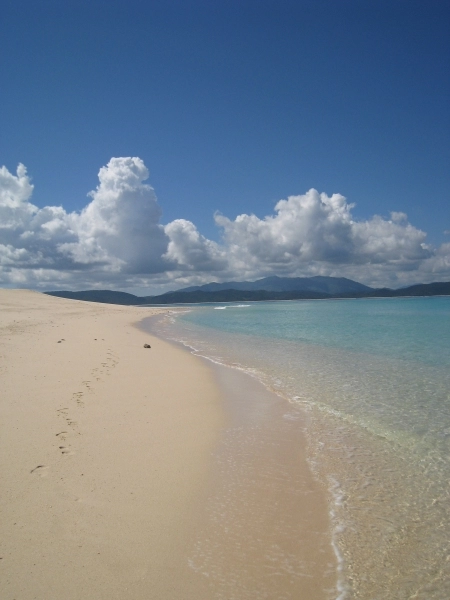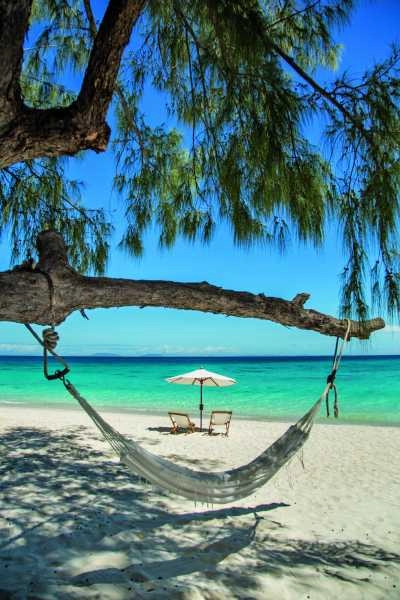Northern Madagascar is dominated by two great mountains. Tsarantanana, the island's highest at 2880m, is covered with the giant ferns and lichens peculiar to high-altitude rainforests. Montagne d'Arbre 1500m is a national park and is famous for its orchids and lemurs. The monsoon falls in the north between December and March.
Nosy Be is Madagascar's most important holiday resort. An island surrounded by smaller islands lying off the northwest coast, it is one hour by air from the capital.

Nosy Be means 'big island' in Malagasy although it only covers an area of about 300km². The main town of Nosy Be is Andoany, formerly known as Hell-Ville.
Exotic perfume plants such as ylang-ylang, vanilla (Madagascar is the world's largest producer), lemon grass and patchouli are grown here. Nearby, there is a ruined 17th-century Indian village.
Temperatures are rather pleasant, except in the summer (December - February), when the night rains combine with the day's heat and result in a tiresome humidity.
Iranja Island
Iranja Island consists of two islands connected by a 1500m sandbank which you can walk across at low tide.
The northern island, Nosy Iranja Be, is home to a delightful lighthouse designed by Gustav Eiffel and a small, traditional African fishing village.
The smaller southern island, Nosy Iranja, is an important breeding reserve for the hawksbill turtle who come to the island to lay their eggs in the soft, warm sand.
The idyllic white beaches of both the islands with their turquoise waters and pristine coral reefs offer fantastic snorkeling, diving and swimming. The bird life is diverse and the lush tropical islands are covered with coconut palms, tropical flowers and huge coconut crabs. A close encounter with one of the giant manta rays or whale sharks which frequent these waters is one of the most exhilarating marine experiences you can hope for!
The northern island, Nosy Iranja Be, is home to a delightful lighthouse designed by Gustav Eiffel and a small, traditional African fishing village.
The smaller southern island, Nosy Iranja, is an important breeding reserve for the hawksbill turtle who come to the island to lay their eggs in the soft, warm sand.
The idyllic white beaches of both the islands with their turquoise waters and pristine coral reefs offer fantastic snorkeling, diving and swimming. The bird life is diverse and the lush tropical islands are covered with coconut palms, tropical flowers and huge coconut crabs. A close encounter with one of the giant manta rays or whale sharks which frequent these waters is one of the most exhilarating marine experiences you can hope for!
Sainte Marie Island

Ile Ste-Marie (Nosy Boraha) is an island which lies off the east coast of Madagascar. Directly translated it is St. Mary's Island. It is approximately 60km long and less than 10km wide. The main town is Ambodifotatra.
The island is less touristy than other beaches in Madagascar making it an ideal romantic honeymoon or getaway.
Its dense vegetation and the difficulty of navigating the lagoons which surround it made it an ideal base for pirates and, later, a colony for convicts. There are many clove plantations and several historic sites, including Madagascar's oldest Catholic church (1837).
The island is also known for its beautiful white-sand beaches and coral reefs. In August, the channel between St Marie Island and Madagascar is a hot spot for whale watching in-particular humpback whales who migrate from the Antarctic to this idyllic breeding place.
The island is also known for its beautiful white-sand beaches and coral reefs. In August, the channel between St Marie Island and Madagascar is a hot spot for whale watching in-particular humpback whales who migrate from the Antarctic to this idyllic breeding place.
Sakatia Island
Sakatia Island is a tropical paradise situated near Nosy Be. There are no roads or motor vehicles on the island. The beauty of the island is explored on the many foot paths found. The island is fringed by spectacular coral reefs so diving and snorkeling is awesome.
Antsiranana
A provincial capital, Antsiranana (formerly Diégo Suarez) is a cosmopolitan seaport overlooking a beautiful gulf at the northernmost tip of the island. There are many lakes, waterfalls and grottoes in the rainforests above the port. Wildlife and flora includes lemurs, crocodiles and orchids. Permission to visit the national park at Montagne d'Arbre nearby must be obtained from the Ministère des Eaux et des Forêts, which has an office in the town. Boats may be taken to Nosy Be. There is a good sandy beach at Ramena, but sharks may be a problem.
A provincial capital, Antsiranana (formerly Diégo Suarez) is a cosmopolitan seaport overlooking a beautiful gulf at the northernmost tip of the island. There are many lakes, waterfalls and grottoes in the rainforests above the port. Wildlife and flora includes lemurs, crocodiles and orchids. Permission to visit the national park at Montagne d'Arbre nearby must be obtained from the Ministère des Eaux et des Forêts, which has an office in the town. Boats may be taken to Nosy Be. There is a good sandy beach at Ramena, but sharks may be a problem.
Mahajanga
Mahajanga is the second most important seaport in Madagascar and stands at the mouth of Madagascar's largest river, the Betsiboka. There is a nature reserve at Ankarafantsika.
Mahajanga has beautiful beaches and a coconut tree-lined boardwalk (La Boru). The beach here is said to be free of sharks.
Boats depart for Nosy Be and several other islands from Mahajanga.
Mahajanga is the second most important seaport in Madagascar and stands at the mouth of Madagascar's largest river, the Betsiboka. There is a nature reserve at Ankarafantsika.
Mahajanga has beautiful beaches and a coconut tree-lined boardwalk (La Boru). The beach here is said to be free of sharks.
Boats depart for Nosy Be and several other islands from Mahajanga.
